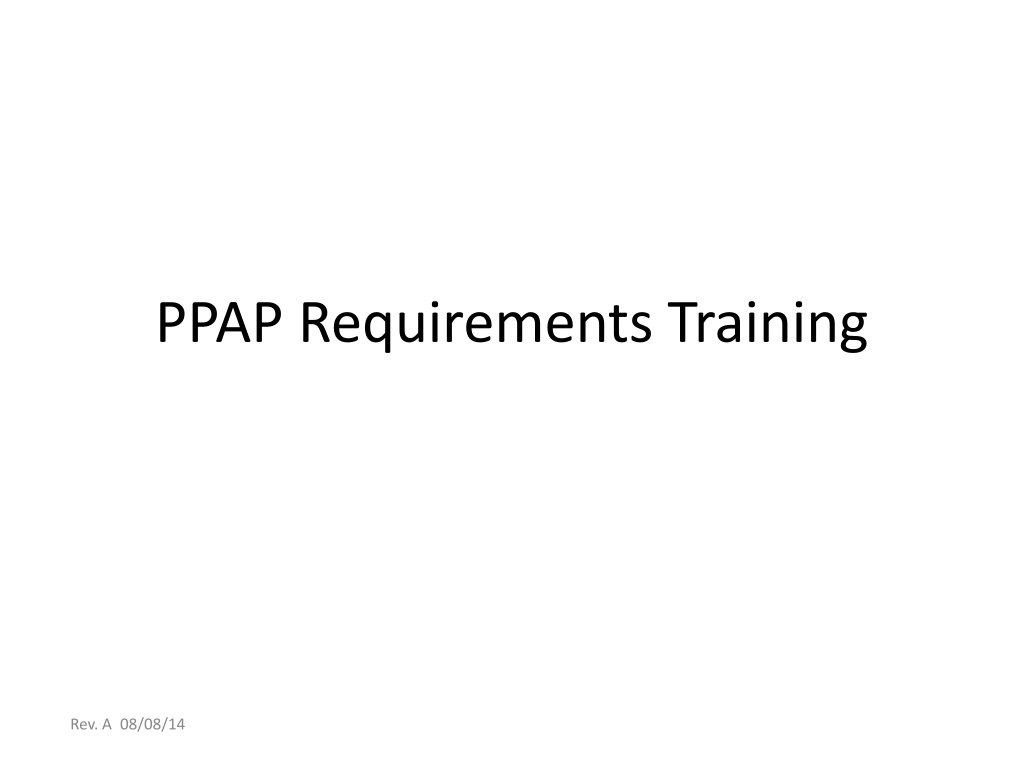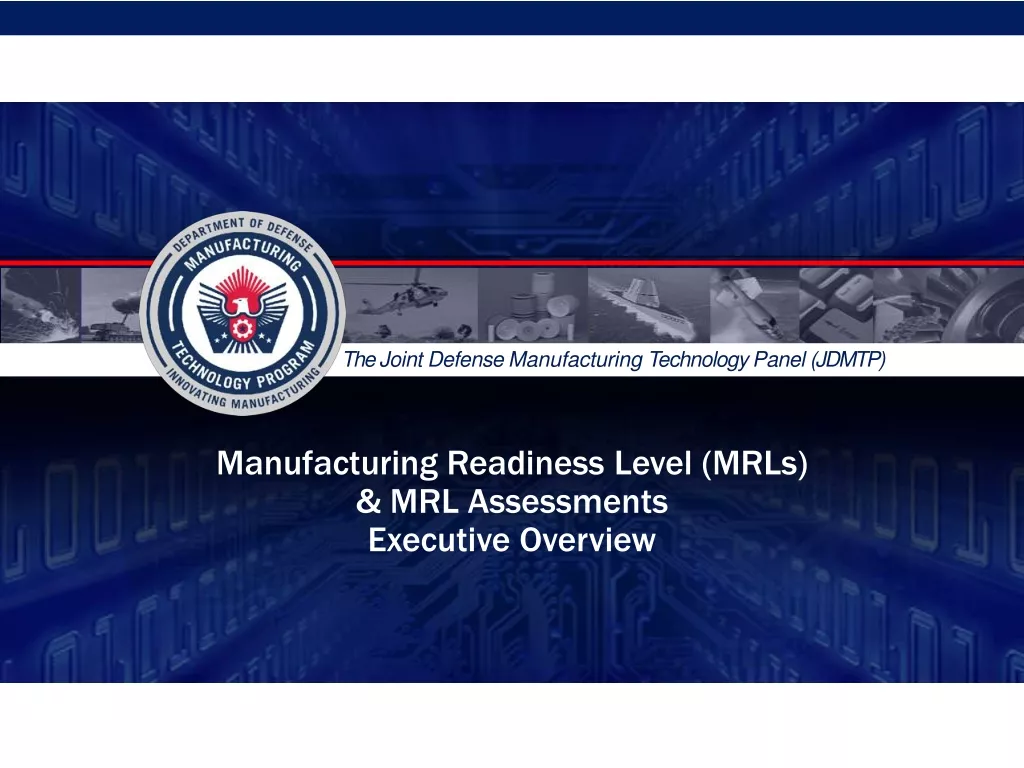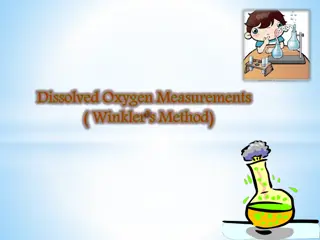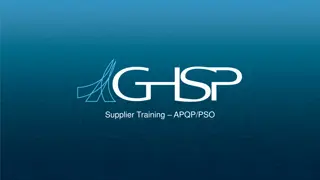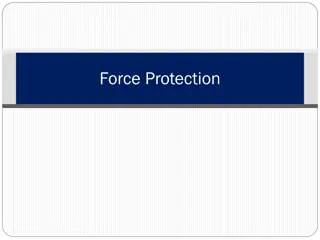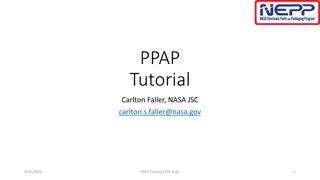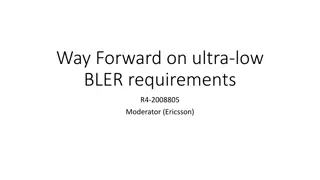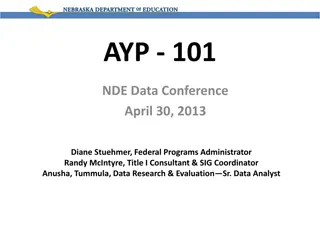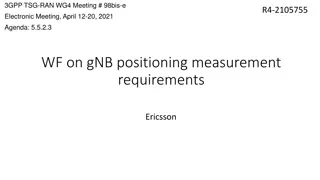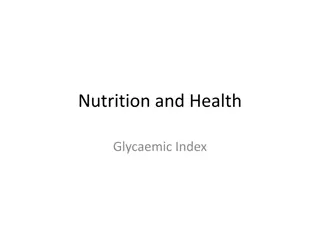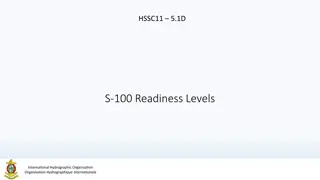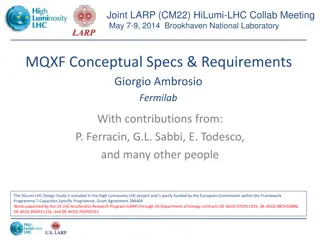PPAP Requirements and Levels
The Production Part Approval Process (PPAP) is crucial for ensuring that suppliers understand customer design requirements and have the capability to consistently produce parts meeting these standards. PPAP levels range from basic documentation to comprehensive quality control measures. This information covers the purpose of PPAP, different levels, and workbook requirements for Level 2 submissions.
Download Presentation

Please find below an Image/Link to download the presentation.
The content on the website is provided AS IS for your information and personal use only. It may not be sold, licensed, or shared on other websites without obtaining consent from the author.If you encounter any issues during the download, it is possible that the publisher has removed the file from their server.
You are allowed to download the files provided on this website for personal or commercial use, subject to the condition that they are used lawfully. All files are the property of their respective owners.
The content on the website is provided AS IS for your information and personal use only. It may not be sold, licensed, or shared on other websites without obtaining consent from the author.
E N D
Presentation Transcript
PPAP Requirements Training Rev. A 08/08/14
What is PPAP? Production Part Approval Process (PPAP) The purpose of PPAP is to determine if all customer engineering design record and specification requirements are properly understood by the Suppliers and the manufacturing process has the capability to produce product consistently meeting these requirements during an actual production run at the quoted production rates
PPAP Level Definitions Level 1 PPAP: One page document that warrants the part meets the design requirements known as a Part Submission Warrant. Level 2 PPAP: Part Submission Warrant (PSW) Dimensional Results per cavity Design Records (Bubble Print) PPAP Samples First production order / upon request prior to production order Print Notes (Attach copy of Raw Material Certification / Performance Test Report / Surface Finish / Labeling, Paint Process, Welding) Supplier Change Request Level 3 PPAP: Includes Level 2 PPAP requirements PLUS Dimensional Results Process Flow Diagrams (PFD) Failure Mode and Effects Analysis (PFMEA / DFMEA) Process Control Plans Initial Process Capability Studies if applicable Measurement System Analysis if applicable Appearance Approval Reports (AAR) if applicable Checking Aids if applicable Records of Compliance with Customer Specific Requirements Master Sample Photo Documentation of PPAP parts Tooling Photo Documentation if applicable Level 4 PPAP Part Submission Warrant (PSW) Dimensional Results Design Records (Bubble Print) PPAP Samples Long Term Benefit
PPAP Workbook Level 2 Requirements INTRO: Type in Part / Supplier Information, this will be transferred throughout the workbook. PPAP REQUIREMENTS: This outlines the PPAP submission requirements. (Informational only) LABELING: This is the label to be used to Identify the PPAP sample part when shipped to HED PSW: This documents the warrant that the Part Meets the design Intent This will be used to communicate back to the supplier the acceptance or rejection of the PPAP DIMENSIONAL: This is used in conjunction with a bubble print to document the actual dimensions of the PPAP part. PRINT NOTES: This is used to document all the remaining notes on print (Attach copy of Raw Material Certification / Performance Test Report / Surface Finish / Labeling, Paint Process, Welding) PRINT NOTES PAINT: This is optional depending if there are Print Notes specifying paint / coating requirements. PRINT NOTES WELDING: This is optional depending if there are Print Notes / Welding requirements specified. Required Always Required where applicable
Intro TAB PPAP Workbook 1. Part Information 2. Supplier Information Note: This information will Be transferred to all like fields In this PPAP Workbook. 1 2 Required Always Required where applicable
PPAP Submission Requirements 1 2 1. Level 2 Submission is the Default PPAP level. 2. List of what is Required based on submission level (Level 1, 2, 3, 4) Required Always Required where applicable
PPAP Parts Labeling Requirements 1 1. All PPAP sample parts must be tagged with this label on the part and / or on the box 2 2. Document all the appropriate Part / Supplier / PO information on the label. Required Always Required where applicable
PSW Part Submission Warrant 1 2 4 3 5 6 8 7 Note: All fields must be completed. If an area is not applicable mark as N/A . Below is a definition of what each numbered section is. 9 10 11 1.) Name of part on drawing 2.) HED part number on PO/drawing 3.) HED part number on drawing 4.) Supplier part number if applicable (n/a if not) 5.) Engineering change level (ex. Rev B, this will be on the drawing / PO) 6.) Engineering date (ex. 4/7/14, this will be on the drawing / PO) 7.) Is this Safety / Government regulation (ex. Drawing will indicate if it is FMVSS, or other industry standard safety regulations. 8.) PO number driving demand for this part / PPAP. 9.) This section requires all applicable supplier location information 10.) Buyer Name 11.) Materials Reporting, acknowledgment the parts meet the hazardous material restrictions outline per the drawing, supplier standards guides or other contract flow down requirements 12.) Check the reason for the PPAP submission 13.) Check the Level of PPAP that was requested by HED and check what documents in the PPAP have been submitted that are applicable for this component 14.) If supplier has HED owned tooling document here. 15.) Supplier point of contact information 12 13 14 15 **DO NOT LEAVE ANY SECTION BLANK. N/A IS OK WHERE NECESSARY** Required Always Required where applicable
DIMENSIONAL RESULTS 3 4 1 2 5 6 1. ITEM: Numbering needs to match Design Records / Bubble Print DIMENSIONAL / SPECIFICATION: Mark the low & high values in the MIN / MAX respectively GAGE TYPE: Mark the gage used to measure item QTY TESTED: Mark how many parts measured (at a minimum 1 piece per cavity if applicable) DATA: Mark actual results OK / NOT OK: Check each measurement as good or bad by marking OK / NOT OK appropriately SIGNATURE SECTION: Fill in Name, Signature, Title and Date for supplier sign off 2. 3. 4. 5. 6. 7. Required Always Required where applicable 7
DIMENSIONAL RESULTS: SAMPLE Required Always Required where applicable
DESIGN RECORD / BUBBLE PRINT: SAMPLE Make sure Design Records (Bubble Print) Matches Dimensional Results numbering Include Notes (word for word) in the specification section of PRINT NOTES 1. MATERIAL: Aluminum alloy 5052 2. FINISH: GREY POWDER COAT RAL 7403 3. ETC ..
PRINT NOTES (ATTACH COPY OF RAW MATERIAL CERTIFICATION, SURFACE FINISH, PERFORMANCE TESTS & PART IDENTIFICATION) 3 4 1 2 5 6 1. ITEM: Numbering needs to match Design Records / Bubble Print DIMENSIONAL / SPECIFICATION: Mark the low & high values in the MIN / MAX respectively GAGE TYPE: Mark the gage used to measure item QTY TESTED: Mark how many parts measured DATA: Mark actual results OK / NOT OK: Check each measurement as good or bad by marking OK / NOT OK appropriately SIGNATURE SECTION: Fill in Name, Signature, Title and Date for supplier sign off 2. 3. 4. 5. 6. 7. Note: This sheet to be used to document all Print Note requirements via the bubble print and reference any applicable Test report numbers in the PPAP package Required Always Required where applicable 7
PRINT NOTES: SAMPLE 1. 2. 3. 4. Design Record Requirement ASTM Chemical Requirement ASTM Mechanical Requirement PPAP document to outline requirement and actual s per the print and industry standard (ASTM) 1 **NOTE** If material certification is the same specification on the drawing, the chemistry and mechanical requirements do not need to be on the Print Notes PPAP sheet. Certifications need to be provided & referenced. 2 3 4
PRINT NOTES: SAMPLE CERT PROVIDED 1. Use Chemical Weighted % from material cert. and transfer to print notes PPAP page. Mechanical Results to be transferred to print notes PPAP Page. Signature on Cert. approving material 2. 3. 1 2 3
PRINT NOTES PAINT (Includes Paint, Plating & Coating Testing) 1. Document what print standard, Industry Standard, & Process Steps that were used to coat the part Prime Coat Verification: Permeability, Adhesion, Thickness Salt Spray Results, Ambient Cure Time & Oven Cure Time Top Coat Verification: Permeability, Adhesion, Thickness, Salt Spray Results, Ambient Cure Time & Oven Cure Time Document plating / coating process Utilized to manufacture this part Supplier Sign Off 2. 1 3. 2 4. 3 5. 4 5 Required Always Required where applicable
PRINT NOTES PAINT: SAMPLE 1 1. Print Note Paint Note Requirement 2. Document what print standard or Industry Standard the part has been painted to. 3. Prime Coat Verification 1. Reference standard for each process step 2. Document blast profile 3. Document actual thickness including profile 4. Ensure that the thickness includes blast (1.0mil blast profile + 1.3 mil primer = 2.3 min thickness including blast profile) 2 3 4. Top Coat Verification 5. Supplier Sign Off 4 5
PRINT NOTES PAINT: Plating Sample 1. 2. 3. Print Note: Plating Requirement Technical drawing requirement Document process required & document standard process executed to plate part Provide Material certification Supplier Sign off 1 4. 5. 2 3 4 5
Welding Specification 3 2 1 1. Document the Welding Symbol / Weld Description from bubble print Document WPS / PQR (if not prequalified) Document visual verification of weld size, Weld length, Weld Quality Supplier Sign Off 2. 3. 4. Note: WPS s and PQR s may be requested and must be provided upon request Required Always 4 Required where applicable
Example: Welding Specification 1. Document the Welding Symbol / Weld Description from bubble print Document the Welding Specification / Weld Symbol from bubble print Document WPS / PQR (if not prequalified) Document visual verification of weld size, weld length, weld quality Supplier sign off 2. 3. 4. 4 3 2 5. Note: WPS s and PQR s must be provided upon request 1 5
PPAP Workbook Level 3 Requirements LEVEL 2 - PPAP LEVEL 3 - PPAP Same Requirements as Level 2 with the following additional requirements: DFMEA Design Failure Mode Effects Analysis is required if the Supplier is design responsibly FLOW DIAGRAM Process Flow diagram is required to outline and standardize the production process that is being approved. This should outline the entire process that is being used to manufacture the component & assembly. PFMEA Process failure Mode Effects Analysis is required to be conducted to understand all the potential failure modes and mitigate know failure modes. CONTROL PLAN The control plan is to be used to document and be used on the shop floor to monitor and control the standardized manufacturing process being approved. MASTER SAMPLE: This is used to document visually how the parts are being marked and pictures of the PPAP parts. Required Always TOOLING This sheet is used to visually document any HED owned tooling. Required where applicable CAPABILITY STUDY This sheet is to be used to show evidence the production process is capable to meet the design intent. This is required when Critical Characteristics are identified on the print or other wise specified by HED GAGE R&R This sheet is to be used to show evidence that the measuring method used for the capability studies is repeatable and reproducible.
DFMEA Design Failure Mode Effects Analysis is required ONLY if the Supplier is design responsible Required Always Required where applicable
Process Flow Diagram Process Flow diagram is required to outline and standardize the production process that is being approved. This should outline the entire process that is being used to manufacture the component / assembly Required Always Required where applicable
PFMEA Process Failure Mode Effects analysis is required to be conducted to understand all the potential failure modes and mitigate any known failure modes. Required Always Required where applicable
Control Plan The Control Plan is to be used to document and be used on the shop floor to monitor and control the standardized manufacturing process being approved. Required Always Required where applicable
Master Sample 1. This section for visually documenting how the parts are being labeled 2. This section for visually documenting how the PPAP parts look 1 Required Always Required where applicable 2
Tooling HED Owned This sheet is used to visually document any HED owned tooling. It is required to attach a picture of tooling as well as the tooling identification method. Required Always Required where applicable
Capability Studies This sheet is to be used to show evidence that the production process is capable to meet the design intent. This is required when Critical Characteristics are identified on the print or otherwise specified by HED Required Always Required where applicable
Gage Repeatability & Reproducibility (Gage R&R) There are multiple examples of Gage R&R forms to use. Use the appropriate form to provide evidence that the measuring method used for the Capability Study is repeatable and reproducible. Required Always Required where applicable
PPAP Workbook Level 4 Requirements INTRO: Type in Part / Supplier Information, this will be transferred throughout the workbook. PPAP REQUIREMENTS: This outlines the PPAP submission requirements. (Informational only) LABELING: This is the label to be used to Identify the PPAP sample part when shipped to HED PSW: This documents the warrant that the Part Meets the design Intent This will be used to communicate back to the supplier the acceptance or rejection of the PPAP DIMENSIONAL: This is used in conjunction with a bubble print to document the actual dimensions of the PPAP part. Required Always Required where applicable
